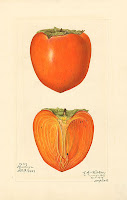In March, while I was staying at Santi Forest Monastery in Bundanoon, I went for a drive with one of the nuns there, Ayya Analaya. We went to Wingello, where Venerable Tejadhammo and the Association of Engaged Buddhists have recently bought a property in order to set up a retreat centre for people suffering serious illness. No one was there when we visited, so we strolled around the grounds. Ayya Analaya identified the different plants and trees, full of delight at the variety and potential she saw in the garden. Near the main house is a large persimmon tree, which was laden with fruit. Some of the persimmons had dropped to the ground, and Ayya found an undamaged one and gave it to me. She told me it was still unripe but would ripen in time.
I took the persimmon home and put it in front of my little Buddha statue where it became slightly more orange, but otherwise didn’t change much. After a while, I moved it into a fruit bowl in the kitchen, where it joined a few small apples. As the weeks went by it became much brighter orange, until I thought it might have been ripe. It was still hard, though, and my mother informed me that persimmons should be quite squishy to touch before they’re ready to eat.
Then last week I returned home after a weekend in Sydney to find the persimmon looking very wrinkly. It was so soft that I was afraid it had rotted. I almost threw it away, but as I’ve never tasted persimmon before, I though I’d at least cut it open and check. Most of the flesh was the consistency of stewed apples. I scooped it out with a spoon and ate it. It was sweet and delicious, which just a hint of tartness where the seeds were enveloped in slightly firmer, very smooth flesh.
Jack Kornfield says that “Great spiritual traditions are used as means to ripen us, to bring us face to face with our life, and to help us see in a new way by developing a stillness of mind and a strength of heart.”
At first, the example of the persimmon made me think that perhaps all that was required for ripening (vegetable or spiritual) was to stay still and wait patiently. Of course, it’s much easier for a persimmon to do this than a human being, but from another angle, it seems encouraging to think that you don’t have to do anything special – ripening will take place of its own accord.
However, I’ve since realized that there was more to the ripening of the persimmon than just the passage of time.
On the weekend, I heard a talk by Venerable Tejadhammo at the Buddhist Expo in Marrickville. He told the story of the Meghiya Sutta (Udana IV.I), about a young monk who is assisting the Buddha when he discovers a charming mango grove. It seems to him to be the perfect place to practice meditation. Three times he asks the Buddha’s permission to go to this grove. In his usual style, the Buddha refuses twice, asking Meghiya to wait until another monk comes. On the third request, the Buddha yields to Meghiya’s obstinacy and tells him, “Do what you think it is now time to do…” Anyone who has read a few of the suttas will realise this is a gentle way of saying, “All right, since you can’t take advice, go and learn from your own mistakes.”
Meghiya goes off to the mango grove, sits down like a piece of fallen fruit to meditate, and finds his mind obsessed with unskilful thoughts: sensual thoughts (involving mangos, probably), thoughts of ill will, and thoughts of doing harm (mangos as missiles..?). It doesn’t sound like a great meditation session, but Meghiya does at least have enough awareness to recognise how unruly, or unripe, his mind is. This comes as a shock. Humbled, he returns to the Buddha, ready to listen this time.
The first piece of advice the Buddha gives to Meghiya is this:
“There is the case where a monk has admirable friends, admirable companions, admirable comrades. In one whose awareness-release is still immature, this is the first quality that brings it to maturity.”
After Venerable Tejadhammo’s talk was over, I had a chat with him, and told him about the persimmon I’d gleaned from his property in Wingello. He said he'd been told that to ripen a persimmon, you should put it in a paper bag with an apple. Apparently the apple absorbs gases released by the persimmon, which helps in the ripening process. So maybe that’s why my persimmon was so delicious – it had spent plenty of time sitting around in a fruit bowl with three admirable apples.
























